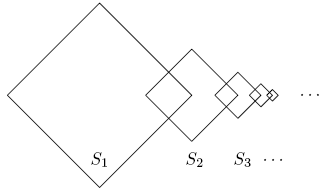1995 AIME Problems/Problem 1
Problem
Square ![]() is
is ![]() For
For ![]() the lengths of the sides of square
the lengths of the sides of square ![]() are half the lengths of the sides of square
are half the lengths of the sides of square ![]() two adjacent sides of square
two adjacent sides of square ![]() are perpendicular bisectors of two adjacent sides of square
are perpendicular bisectors of two adjacent sides of square ![]() and the other two sides of square
and the other two sides of square ![]() are the perpendicular bisectors of two adjacent sides of square
are the perpendicular bisectors of two adjacent sides of square ![]() The total area enclosed by at least one of
The total area enclosed by at least one of ![]() can be written in the form
can be written in the form ![]() where
where ![]() and
and ![]() are relatively prime positive integers. Find
are relatively prime positive integers. Find ![]()
Solution
The sum of the areas of the squares if they were not interconnected is a geometric sequence: $1^2 + (\frac{1}{2})^2 + \1dots + (\frac{1}{16})^2$ (Error compiling LaTeX. Unknown error_msg). Then subtract the areas of the intersections: $(\frac{1}{4})^2 + \1dots + (\frac{1}{32})^2$ (Error compiling LaTeX. Unknown error_msg). The majority of the terms cancel, leaving ![]() , which simplifies down to
, which simplifies down to ![]() . Thus,
. Thus, ![]() .
.
Alternatively, take the area of the first square and add ![]() of the areas of the remaining squares. This results in $1 + \frac{3}{4}(\frac{1}{2}^2 + \1dots + \frac{1}{16}^2)$ (Error compiling LaTeX. Unknown error_msg), which when simplified will produce the same answer.
of the areas of the remaining squares. This results in $1 + \frac{3}{4}(\frac{1}{2}^2 + \1dots + \frac{1}{16}^2)$ (Error compiling LaTeX. Unknown error_msg), which when simplified will produce the same answer.
See also
| 1995 AIME (Problems • Answer Key • Resources) | ||
| Preceded by First Question |
Followed by Problem 2 | |
| 1 • 2 • 3 • 4 • 5 • 6 • 7 • 8 • 9 • 10 • 11 • 12 • 13 • 14 • 15 | ||
| All AIME Problems and Solutions | ||










